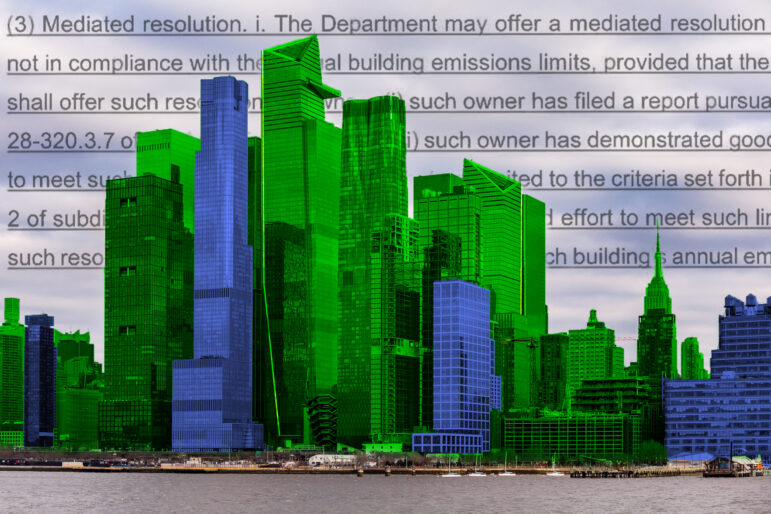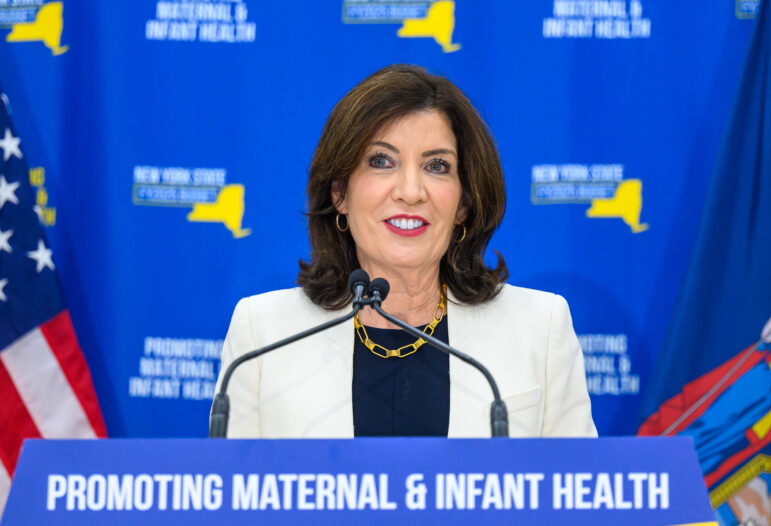The Dept. of Buildings has the power to offer a mediated resolution to landlords who don’t comply with the city’s building emissions law, bypassing fines if they promise to get back on track. But lawyers fear the provision leaves the door open for DOB to evoke it too freely, and question whether the agency has the staff capacity to monitor such deals.

Photo by Adi Talwar, Graphic by Chris Janaro
Skyscrapers along Manhattan’s west side.New York City’s landmark climate law, Local Law 97 (LL97), kicked into gear this year promising to curtail carbon pollution from buildings, which contribute to nearly 70 percent of the city’s greenhouse gas emissions.
That means owners of properties larger than 25,000 square feet that pollute above certain limits will face fines beginning next year.
But regulations issued by the Department of Buildings (DOB) for implementing LL97 include an overlooked rule that allows building owners to avoid the penalties and enter into a “mediated resolution” with the city instead. The provision gives DOB the power to offer landlords a legally binding agreement tailored to their property, skipping the initial fine in exchange for future compliance.
Lawyers who spoke with City Limits say the definition of what makes a building eligible for a mediated resolution is so “vague” that it opens the door for DOB to evoke it too freely.
The rules state that non-compliant buildings can qualify for a mediated resolution if they show “good faith efforts” to meet their emissions limits. But they extend that even further to building owners who show any “other demonstrated effort” to comply.
“DOB has given themselves a blank check to do whatever they want,” said William McCracken, a partner at the law firm Moritt Hock & Hamroff LLP whose clients are largely co-ops and condo boards. “The rule doesn’t say what kinds of efforts would qualify for a mediated resolution and it doesn’t say what the mediated resolution would entail.”
The DOB insists the option is not a get out of jail free card. “Failure to uphold the agreement on the part of the building owner will result in DOB issuing any penalties that were previously avoided,” an agency spokesperson said in an email.
But given that only 11 employees are currently in charge of enforcing LL97 at the DOB, advocates fear it could be difficult for the city to ensure owners aren’t using the clause as an escape hatch to avoid making meaningful progress on lowering their property’s pollution output.
“They’re not going to be in a position to do a real deep dive into the intentions of each particular landlord,” said Pete Sikora, climate and inequality campaigns director at New York Communities for Change.
“Building in mediation mechanisms [into the rules] signal to those that can afford sophisticated lawyers to work the system, that they can get a free pass. So this is a recipe for letting people off the hook.”
‘A lot of leeway’
Local Law 97 sets a cap on the amount of carbon large New York City buildings can emit over a series of compliance periods, which start this year and get stricter over time.
By May 1 of 2025, buildings covered by LL97 will be required to file their first report with the DOB detailing their annual greenhouse gas emissions.
About 1,400 properties won’t meet 2024’s carbon emissions limits set by the law, and can be subjected to a fine of $268 for every metric ton of carbon dioxide above their caps, according to the DOB.
“So we’re left with two options. We either fine them and forfeit the carbon savings that we need, or we find a practical way to get them back onto a compliance path so that they catch up,” said John Mandyck, CEO of the decarbonization research hub Urban Green Council.
One practical way to get landlords back on track is to offer a mediated resolution. Such a provision is commonly used by government agencies in environmental law and it’s natural that it was incorporated into Local Law 97, experts say.

Adi Talwar
New boilers, and new ways of controlling boiler performance and ensuring that heat is delivered efficiently to buildings, are likely to be on the to-do list for many property owners facing the new requirements of Local Law 97.In this case, the mediated resolution is on the table if the landlord has filed an annual carbon emissions report, has proven that the resolution will help the building comply with the law in the future, and has demonstrated “good faith efforts” to meet their emissions targets.
The rules include a long list of that “good faith effort” criteria, including that landlords are up to date with earlier city rules for large buildings: measuring their energy consumption under Local Law 84, plus upgrading to more efficient lighting and establishing a submetering system, as required by Local Law 88.
Building owners must also choose one out of six possible pathways to prove that they qualify for the exemption, like providing a detailed plan to decarbonize their building or show “that work necessary to achieve compliance is currently underway.”
But a clause squeezed into the rules that has gone largely overlooked adds that buildings are “not limited to” meeting the criteria outlined in the regulations to qualify for the exemption. It says landlords can show any “other demonstrated effort” to meet their emissions limits to get a mediated resolution offer from the DOB.
“The way that the regulations are written leave some open questions about what this mediated resolution is actually going to look like,” said Alexis Saba, an environmental attorney and associate at Sive Paget & Riesel, P.C. The lawyer described the language in the clause as “vague” because it “leaves a window” open for DOB to grant the resolution at the agency’s choosing.
According to McCracken, as written, the rules award DOB a “tremendous amount” of discretion to evoke the clause as they see fit. “[DOB] has basically given themselves a lot of leeway to chart a course of action for any particular building,” McCracken said.
“That’s not to say that this will be a way for people to get a free pass,” he added. “It may or may not be, but I think it’s something that we should all be watching very closely.”
In response to those concerns, a DOB spokesperson confirmed that the rules give the agency discretion around mediated resolutions, and said that “the city is fully committed to enforcing Local Law 97 and helping buildings mobilize to reduce their emissions, improve local air quality, and comply with the law.”
“Our second major LL97 rule package does recognize that a building may be making a real effort to comply with the law but might also have unique extenuating circumstances not specifically covered in our rule, that could potentially be considered by DOB under its discretionary authority,” the spokesperson said in an email.
Staffing concerns
For now, the DOB says they have no immediate plans to change the language in the mediated resolution clause, though the agency has yet to finalize specific rules for when more stringent emissions thresholds hit in 2030 and 2050.
“Future DOB rulemaking will detail ‘good faith efforts’ for subsequent Local Law 97 compliance periods starting in 2030 that may be different,” the department said.

Credit John McCarten/NYC Council
Activists and lawmakers at a 2022 rally calling for City Hall to provide adequate resources for Local Law 97’s implementation.They do promise, however, to thoroughly examine each individual case that ends up at the mediating table. “When a mediated resolution is entered into, it will be a specific agreement for the particular property,” a DOB spokesperson said.
In addition to its current 11-person enforcement team, the department’s budget includes seven more positions that are yet to be filled, according to the DOB.
“We are actively working on staffing up the Local Law 97 team over the next 15 months, leading up to the first compliance deadline on May 1, 2025. This includes filling the vacant positions dedicated to the implementation of Local Law 97,” a spokesperson said in an email.
But lawyers and advocates who spoke with City Limits questioned the DOB’s capacity to deal with each property owner on such an individual basis, along with reviewing the emissions reports of every building covered by the law.
“The fact that New York City’s Department of Buildings only has 11 inspectors reviewing and monitoring the compliance of 50,000 of the city’s largest buildings is alarming,” said Eliza Klein, clean energy program manager at WE ACT for Environmental Justice.
“The city does not currently have adequate budget or staffing to hold these buildings accountable. So we urge the mayor to plan for success instead of failure,” she added.
Sikora, of New York Communities for Change, said the understaffing, “in practice, creates a de facto slap on the wrist regime.”
“If hundreds of landlords are coming in with complex adjudications into the Department of Buildings, the department will simply be overwhelmed,” he said. “And in that situation it becomes hard for them to do anything other than just get out the big old rubber stamp and start rubber stamping everything.”
To reach the reporter behind this story, contact Mariana@citylimits.org. To reach the editor, contact Jeanmarie@citylimits.org.








One thought on “Local Law 97’s ‘Mediated Resolution’ Clause Gives Too Much Leeway for Exemptions, Lawyers Say”
Thanks for sharing this info